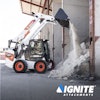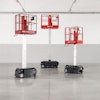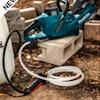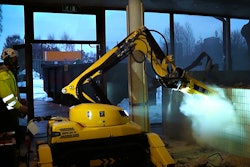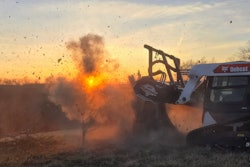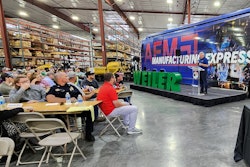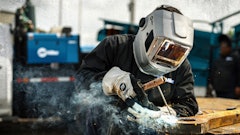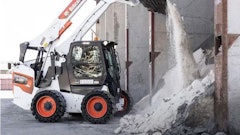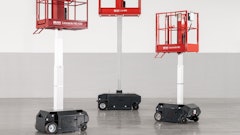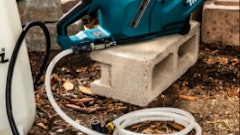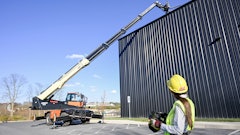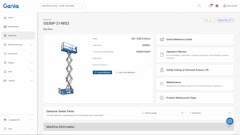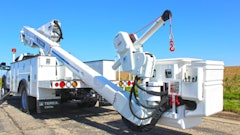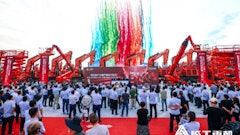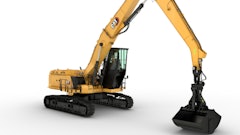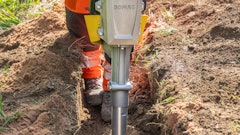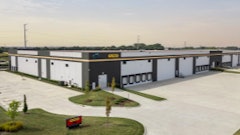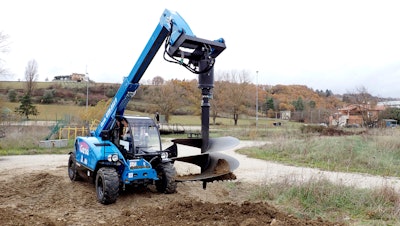
Telehandlers are versatile tools for construction and utility contractors. Their attachments extend this flexibility even further. Keeping up with new lift attachments and selecting the ideal attachment for the job is essential for success.
Attachment Versatility
Amalija Kopac, senior global product manager for Genie, explains that telehandlers are essential tools used in applications where material must be lifted and moved or placed indoors and outdoors for new construction or upgrading existing infrastructure.
“Attachments contribute even further to this versatility and utilization,” Kopac said. “The range of attachments for use with all sizes of telehandlers is expanding—from compact telehandlers to high-capacity machines.”
Steve Kiskunas, product manager for Manitou, agrees that contractors, equipment, rental centers and other fleet managers increasingly recognize the versatility of attachments for telehandlers. “Whether it’s the capability of more compact models using traditional skid steer and compact track loader (CTL) attachments, rotating telehandlers offering an increasing number of attachments to further the extensive multipurpose capabilities of those machines or traditional fixed-boom telehandlers adding a little versatility—telehandlers are excellent attachment platforms [because of] their strength, mobility and reach.”
Telehandler & Attachment Benefits
The concept of doing more with less applies to telehandlers and their attachments.
 An auger attachment on a telehandler is ideal if you need to work across a ditch to drill.Genie
An auger attachment on a telehandler is ideal if you need to work across a ditch to drill.Genie
“Attachments contribute to making telehandlers the versatile jobsite tool contractors love and what expands fleet [use] for rental companies,” Kopac said. “Attachments allow workers to do more with less equipment.”
Kiskunas added that, while many don’t often think of telehandlers for attachments, their core performance benefits make them well-suited for attachment use.
Consider the following benefits:
- Extreme mobility is provided with four-wheel drive.
- Added lifting strength and performance is available compared to more compact equipment.
- Reach made possible, whether it’s a telescopic boom or a rotating telehandler, can be a game changer for equipment owners.
- The strong wheelbase and the stabilization capabilities of most telehandlers provide excellent stability for handling larger loads and attachments.
Attachment Compatibility
When considering attachments, assessing compatibility with the telehandler is crucial.
“Coupling styles vary depending on the type of telehandler you have. Knowing the type of coupler you have and [talking] with your equipment dealer will help you quickly narrow the scope of attachments available for your … machine,” Kiskunas said.
Kiskunas stated that another critical part of the selection process is acquiring attachments that are correctly sized and matched to the machine to ensure optimal performance based on weight and machine capabilities. Users can also refer to the manufacturer’s website, which typically lists which attachments are compatible with each machine from a sizing standpoint.
“The auxiliary hydraulic performance and type/size of [the] machine’s connectors are also important to understand and to make sure it’s compatible with each attachment,” Kiskunas said.
In addition, Kopac recommends that contractors become familiar with American National Standards Institute/Industrial Truck Standards Development Foundation B56.6, which provides safe use requirements for telehandlers, including the use of attachments. This standard applies to U.S. and Canadian users.
Kopac noted that attachment use directly impacts a telehandler’s lifting capacity and stability. Every attachment needs a corresponding load chart for the make and model of the telehandler it’s paired with. Improperly using attachments can contribute to tip-overs.
“While an attachment may be marketed as universally compatible, there are unknowns with aftermarket attachments,” Kopac said. “If you are not considering an original equipment manufacturer (OEM)-supplied or OEM-approved attachment with a load chart, always check with the OEM before using.”
Trending Attachment Options
Current telehandler attachment trends help control costs and increase productivity. Kiskunas has noticed a greater use of work platforms as attachments on telehandlers.
“While there are dedicated machines for providing elevated work platforms, a work platform as an attachment on a telehandler provides an extremely versatile option for … greater access to work areas and may allow you to have fewer machines on a … site,” Kiskunas said. “Having fewer machines on each site is great for safety and site traffic—and ultimately allows you to control equipment costs on each job and be smart about deploying equipment across numerous jobs.”
Kiskunas has also seen more people accepting compact telehandlers as an option for operating skid steer and CTL attachments.
“With the skid steer attachment mount, that capability opens up compact telehandlers to be used with countless attachments that extend their capabilities on each site,” Kiskunas said.
While there are some applications that compact telehandlers may not be built for (such as fine grading), many common skid steer or CTL tasks can be performed just as well with a compact telehandler, increasing lift capacities and reach.
 Once a telehandler with the right capacity is selected, you’ll be able to determine what attachments are compatible with that machine.Genie
Once a telehandler with the right capacity is selected, you’ll be able to determine what attachments are compatible with that machine.Genie
“Similarly, other options are intended to increase efficiency and productivity. Rotating carriages make common tasks like picking and placing pallets easier. Genie’s Rotate Carriage—which comes in 48-inch, 60-inch and 72-inch options—allows for up to 10 degrees of clockwise or counterclockwise carriage rotation if you’re working on a surface that is not level,” Kopac said.
To increase placement productivity, Genie’s 48-inch side-shift carriage enables the operator to shift the load up to 8.25 inches without exiting the telehandler’s cab, according to Kopac.
“This [side-shift carriage] enhances productivity by reducing the need to reposition the telehandler when picking or placing the load,” Kopac said. “The most common pallet size is 40 inches x 48 inches, but not all loads are the same shape and size. Genie’s new fork positioner carriage allows an operator to adjust the width of the forks inside the cab to account for this difference in load shape and size. This eliminates the hassle of manually adjusting the forks.”
Kopac also pointed out that Genie is always looking for ways to eliminate the manual handling of materials and provide more precise load placement.
“Using the right telehandler for the application, equipped with the best attachment for the task, is one way to accomplish that goal,” Kopac said. “Any time we can move people away from the load on the forks (or bucket, truss boom, etc.), the more risk can be reduced in the operation.”
Beneficial Technology for Attachments
The latest technology available for attachments enhances performance and safety. Kiskunas believes one promising technology combination is using rotating telehandlers with remote control technology and complementing that with a complete set of attachments.
“We’ve seen large-scale residential and commercial contractors essentially use their rotating telehandler as a jobsite material delivery tool,” said Kiskunas. “It is positioned in a central location on the jobsite and then used with a plethora of attachments from forks to jibs to work platforms.”
Kiskunas pointed out that it is particularly dynamic because the operator can stand with a remote control and operate the machine outside the cab. This allows the operator to be closer to the work and have greater control over the attachment’s performance.
“Instead of a worker on the ground shouting directions to the operator of the telehandler, the operator can simply stand where the attachment is used and monitor/adjust performance from there,” Kiskunas said.
Kopac said that another technology advancement includes a new auger attachment. According to Kopac, this attachment was developed specifically for the Genie GTH-5519 and comes with a HALO LED alignment system, an LED light ring that provides a visual aid to operators and eliminates the need for a spotter. Lights help the operator ensure that the hole is drilled at the correct angle.
Selecting the Ideal Telehandler Attachments
Specific criteria should be considered when selecting an attachment for a telehandler. Kopac also suggested that picking the right equipment starts with considering what a full day of work looks like, including how much you’ll be lifting and how high and/or how far you need to lift it.
Kopac believes answering these questions will ensure that you select a machine with enough capacity and reach. Every telehandler has a load chart that shows the maximum capacity based on how high and far the boom is extended.
“Once you’ve selected a telehandler with the right capacity, you’ll be able to determine what attachments are compatible with that machine,” Kopac said. “The application dictates what type of attachment would be best.”
Kopac described the following attachments:
- Multipurpose bucket attachments can be used to move loose, unpalletized material such as dirt, sand, gravel or mulch.
- Grapple buckets use hydraulically operated jaws to grip and clamp down on heaped loads or hard-to-handle materials, like tree branches, landscaping material or demolition debris.
- Different fork and carriage sizes provide options. Masonry work, for example, generally needs narrow forks and a narrow carriage. Framers are better served with a wide carriage and wider forks.
- An auger attachment is a good solution for drilling holes with obstructions, such as reaching over a ditch to drill holes for a fence or utility poles.
- Truss boom attachments can be used to lift and place longer, bulky objects like roof trusses, beams or poles. This is useful for positioning roof trusses during construction or renovation and lifting and placing wall panels, beams, columns or utility poles.
Kiskunas recommends these considerations when selecting an attachment:
- It should add a capability to your equipment offering that allows you to do more and use fewer other machines onsite.
- It allows you to expand your business capabilities and rely less on other contractors or subcontractors.
- It increases the telehandler’s use throughout your day-to-day work (more use means more opportunities to invoice for that machine).
“We see attachments as being great business-boosting assets,” Kiskunas said. “And telehandlers can be a powerful platform to carry and work with them.”

